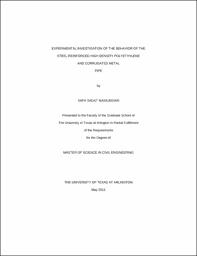
ATTENTION: The works hosted here are being migrated to a new repository that will consolidate resources, improve discoverability, and better show UTA's research impact on the global community. We will update authors as the migration progresses. Please see MavMatrix for more information.
Show simple item record
| dc.contributor.author | Masajedian, Safa Sadat | en_US |
| dc.date.accessioned | 2011-10-11T20:47:55Z | |
| dc.date.available | 2011-10-11T20:47:55Z | |
| dc.date.issued | 2011-10-11 | |
| dc.date.submitted | January 2011 | en_US |
| dc.identifier.other | DISS-11240 | en_US |
| dc.identifier.uri | http://hdl.handle.net/10106/6131 | |
| dc.description.abstract | Steel reinforced high density polyethylene pipes are gaining popularity these days because of their good performance and advantages of them in comparison to the other pipe materials. By inverting the steel ribs vertically in to the HDPE materials, strength of steel and flexibility and light weight of HDPE materials have been combined. However due the limited study in this area, the failure modes and design parameters are not classified.This study investigates the behavior and failure modes of SR-HDPE pipes under the simulated soil load and compares the results with the data obtained from the test on corrugated metal pipe under the identical test scenario. Full-scale experimental tests were conducted with soil boxes in order to determine if the steel ribs in SR-HDPE act continuously throughout the pipe structure. Local and global deformations of the pipe were monitored with displacement transducers and strain gauges, respectively. Strain gauges were placed at two sections of the pipe. Each section contained six strain gauges at the crown, springline, and invert. Displacement transducers were installed in two sections along the pipe (middle and 12 in.(31 cm) from the end). Each section was capable of monitoring the vertical deflection and the horizontal deflection was measured at mid section. The load was applied through a hydraulic cylinder, and a rigid concrete slab. The data from these sensors were recorded and reported to identify the response of the pipes with regard to strength and serviceability. Three different pipe sizes (24 in. (61 cm), 36 in. (91 cm), and 48 in. (122 cm)) were tested in this situation and three different concrete slabs were cast whose dimensions were fixed by the pipe length which was 4 ft. (122 cm) and pipe and its width varied based on internal diameter.The results showed that the CMP pipe has higher stiffness and load carrying capacity. Also CMP exhibited more ductility before the failure. The governing failure mode of the SRHDPE pipe tested was lateral buckling of the ribs along the horizontal axis of the pipe at crown and springlines. This was due to the premature buckling of the HDPE material supporting the steel ribs, thus, causing discontinuous steel action. This study shows that the behavior of the SR-HDPE is different than the CMP pipe. By inspecting the pipe after reloading and removing from the soil box, three failure lines (crease) for 24 in. (61 cm) SR-HDPE and four failure lines for 36 in. (91 cm), and 48 in. (122 cm) SR-HDPE which is explained by the higher hoop capacity of the 24 in. (61 cm) SR-HDPE pipe in comparison with other pipe sizes. However CMP pipes exhibited a continuous hoop type buckling and smooth plastic hinge. | en_US |
| dc.description.sponsorship | Abolmaali, Ali | en_US |
| dc.language.iso | en | en_US |
| dc.publisher | Civil & Environmental Engineering | en_US |
| dc.title | Experimental Investigation Of The Behavior Of The Steel Reinforced High Density Polyethylene And Corrugated Metal Pipe | en_US |
| dc.type | M.S. | en_US |
| dc.contributor.committeeChair | Abolmaali, Ali | en_US |
| dc.degree.department | Civil & Environmental Engineering | en_US |
| dc.degree.discipline | Civil & Environmental Engineering | en_US |
| dc.degree.grantor | University of Texas at Arlington | en_US |
| dc.degree.level | masters | en_US |
| dc.degree.name | M.S. | en_US |
Files in this item
- Name:
- MSc_Thesis_Safa_Masajedian..pdf
- Size:
- 8.098Mb
- Format:
- PDF
- Description:
- PDF
This item appears in the following Collection(s)
Show simple item record


